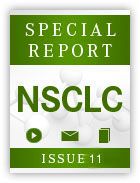Erlotinib/Bevacizumab Combo Warrants Consideration for EGFR+ NSCLC
The promising clinical efficacy seen with the combination of erlotinib and bevacizumab as a treatment for patients with <em>EGFR</em>-mutant non–small cell lung cancer warrants widespread consideration.
H. Jack West, MD

H. Jack West, MD
The promising clinical efficacy seen with the combination of erlotinib (Tarceva) and bevacizumab (Avastin) as a treatment for patients withEGFR-mutant nonsmall cell lung cancer (NSCLC) warrants widespread consideration, according to a presentation by H. Jack West, MD, during the 11th Annual New York Lung Cancer Symposium.
“I would consider erlotinib/bevacizumab a combination worth considering and, when offering my own perspective, it’s actually an approach that I use in most of my patients with active EGFR mutations,” said West, a thoracic oncologist of Swedish Cancer Institute at Swedish Medical Center. “It’s not a clear standard of care, but it is the approach I use a lot. For the patients where bevacizumab is not an appropriate choice, I use afatinib for the most robust, and erlotinib alone for the rest.”
While not yet specifically approved for use in the United States, the European Medicines Agency has approved the combination as a frontline treatment for patients with unresectable advanced, metastatic, or recurrentEGFR-mutant NSCLC in June 2016. The European approval was based on findings from the phase II JO25567 study, which demonstrated a 46% reduction in the risk of progression or death with erlotinib/bevacizumab versus single-agent erlotinib.
In the open-label JO25567 study, which was conducted in Japan, 152 patients with untreatedEGFR-mutant NSCLC received erlotinib alone (n = 77) or in combination with bevacizumab (n = 75). Erlotinib was administered at 150 mg per day and bevacizumab was given at 15 mg/kg every 3 weeks.
Patient characteristics were well balanced between the 2 arms, with a median age of 67 years in both groups. Eighteen percent of patients were over the age of 75. More than half of patients were never smokers (56% to 58%) and all patients had an ECOG PS of 0 or 1.EGFRmutations subtypes were well balanced between exon 19 deletions and exon 21 mutations.
The median PFS with bevacizumab plus erlotinib was 16 months compared with 9.7 months with erlotinib alone (HR, 0.54; 95% CI, 0.36-0.79;P= .0015). This improvement in PFS for the combination versus erlotinib monotherapy was seen across patient subgroups, including those aged ≥75 years (HR, 0.23; 0.17-0.74). Overall survival data were immature at the time of the analysis.
Exon 19 deletions and 21 mutations played a factor in outcomes, West noted. The median PFS was 18.0 months with the combination versus 10.3 months with erlotinib alone in the exon 19 deletion subgroup (HR, 0.41; 95% CI, 0.24-0.72;P= .0011). In the exon 21 mutation group, the median PFS was 13.9 versus 7.1 months for the combination and single-agent, respectively (HR, 0.67; 95% CI, 0.38-1.18;P= .1653).
“[The combination] demonstrated a significantly better disease-control rate, and a trend toward a better response rate overall,” said West. “We have not seen the follow-up yet […] but the benefit for the combination is impressive for both of these populations.”
Toxicities poised a challenge with this regimen, as grade 3/4 adverse events (AEs) occurred in 91% of patients treated with the combination compared with 53% with single-agent erlotinib. The most commonly observed grade 3/4 AEs were rash (25% vs 19%), hypertension (60% vs 10%), and proteinuria (8% vs 0%) for erlotinib/bevacizumab and erlotinib, respectively. Sixteen percent of patients in the combination arm discontinued treatment due to AEs versus 18% in the erlotinib-alone arm.
Regardless, West said the question is: “Is this something that is a standard of care? At this point, many of are in favor of adopting.”
For those withEGFRmutations, there is a continued need to optimize care, as the checkpoint inhibitors are not recommended in this setting, noted West. In the CheckMate-057 trial, which compared the efficacy of nivolumab (Opdivo) versus docetaxel in pretreated patients with nonsquamous NSCLC, the 2-year OS rate was 29% with nivolumab versus 16% with docetaxel. However, this was not the same across all subgroups.
“The only subset that did not do well were the patients who were EGFR-positive,” West said. “The point is that [these] patients don’t seem to be big beneficiaries, at least with that drug in that setting.”
West also cautioned use of combination treatments of immunotherapies and EGFR TKIs as there is a lack of clinical data supporting efficacy and safety of them. He says to “never not do it,” but to use it as a later-line therapy rather than an available EGFR inhibitor.
“We don’t have a lot of data yet except for the discontinuation of a trial of durvalumab and osimertinib combined, where we saw higher levels of pulmonary toxicities than were expected,” he explained. “That should give us pause about being cavalier about doing ad-hoc combinations.”
Seto T, Kato T, Nishio M, et al. Erlotinib alone or with bevacizumab as first-line therapy in patients with advanced non-squamous non-small-cell lung cancer harbouring EGFR mutations (JO25567): an open-label, randomised, multicentre, phase 2 study. Lancet Oncol. 2014;15(11):12361244.

Survivorship Care Promotes Evidence-Based Approaches for Quality of Life and Beyond
March 21st 2025Frank J. Penedo, PhD, explains the challenges of survivorship care for patients with cancer and how he implements programs to support patients’ emotional, physical, and practical needs.
Read More